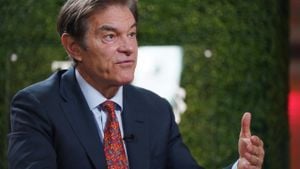Recent developments in the scientific investigation surrounding the origins of COVID-19 have reignited discussions about the widely popular yet highly controversial lab leak theory versus the established zoonotic spillover hypothesis. A fresh study from renowned international researchers brings to light compelling evidence supporting the idea of the virus's natural emergence from animals, casting doubt on claims of laboratory manipulation.
Pursued by some as the definitive answer to the virus’s origin, the lab leak theory has captured widespread attention, particularly among segments of the political discourse. This narrative hinges on the notion of SARS-CoV-2, the virus responsible for COVID-19, spilling from the Wuhan Institute of Virology (WIV) during research activities involving bat coronaviruses. Yet, the latest research sheds light on findings from the Huanan Seafood Wholesale Market, the site known to be at the epicenter of the outbreak, emphasizing instead the role of wildlife trade.
Published in the journal Cell, the study analyzed over 800 genetic samples collected shortly after the outbreak began and highlights the specific wildlife trades occurring at the market. Key species linked to the outbreak include raccoon dogs, civet cats, and bamboo rats, particularly within certain stalls known for selling these animals. The research team, including esteemed scientists Edward C. Holmes and Michael Worobey, determined through advanced genetic techniques the likely pathways of viral transmission from animals to humans.
Michael Worobey, one of the study's co-authors and an evolutionary biologist based at the University of Arizona, remarked, "This may be the last big, new set of data directly from the market, and it's like finishing the last piece of a puzzle showing the picture has been pretty clear already.” His sentiment emphasizes the rigorous nature of the research and aligns with previous findings about the complex interplay between wildlife and human populations when it concerns disease spillover.
Intriguingly, shortly after the market was shuttered on January 1, 2020, teams from the Chinese Centers for Disease Control conducted extensive samplings within the premises, focusing on surfaces and areas where wild animals were sold. Their findings, published earlier this year, revealed the presence of SARS-CoV-2 RNA, reinforcing the hypothesis of natural transmission due to markets being hotspots for live animal trade.
Dr. Florence Débarre, also involved with the investigation, highlighted this early sampling work, stating, “Many of the key animal species had been cleared out before the Chinese CDC teams arrived, so we can’t have direct proof, but we observe the remnants of what is consistent with the presence of infected animals.” Their research underlines the potential for zoonotic viruses to emerge from interactions between wildlife and human communities, particularly when animals are kept and sold under stressful conditions.
Expanding on the zoonotic origins, prior indications of rampant SARS-related coronaviruses among animals beyond China bolster the notion of natural outbreaks. Evidence gathered by EcoHealth Alliance and the WIV about high rates of coronavirus infections across various Asian regions suggests risks of spillover events are substantial. An estimated 66,000 infections found annually across these populations reflect the potential for such pathogens to jump to humans, amplifying concerns over wet markets.
“The evidence surrounding the conditions of the wildlife trade lends credence to the zoonotic theory more than the laboratory-origin explanations,” Dr. Worobey stated. He referred to the geographical movement of animals from southern China to Wuhan as indicative of trade routes. Such movements could align with how SARS-CoV-2 exposed humans to the virus, much akin to how previous coronaviruses have emerged.
With respect to the specifics of the genetic analysis from the Huanan market, it indicated clusters of SARS-CoV-2 positive samples gathered from wildlife stalls directly tied to contaminated surfaces. The correlation between these findings and the initial spread of COVID-19 suggests convincing evidence for the market being where the virus first entered the human population.
The vast web of evidence encompassing genetic sequencing, environmental sampling, and the historical trade of wildlife paints the Huanan market as central to the early outbreak. The first significant clusters of cases were closely linked to this location, diminishing the validity of claims linking the virus back to the laboratories situated over 30 kilometers away.
Despite the prominent elevation of lab leak theories by various political entities, evidence strongly limits speculation around the WIV. The absence of direct connections between lab workers and early COVID-19 cases sways the narrative back to wildlife’s role as the primary interface between the virus and human populations.
Critical voices and researchers within the scientific community remain vigilant against premature conclusions drawn from circumstantial evidence. The clear distribution of infection outbreaks surrounding the wildlife trade suggests the necessity for stronger regulation and safety protocols aimed at preventing zoonotic spillovers from infecting human populations.
Adding another layer to this debate is the reaction from various political leaders and institutions to the findings detailed within this study. For many, the shift back to natural origins from zoonotic transmission exposes the fragile foundation of lab leak claims, which had initially gained momentum amid public discourse concerning the pandemic's origins.
Dr. Holmes reiterated the importance of scientific clarity amid misinformation, asserting, "While the lab leak may seem appealing, it lacks solid evidence. The initial breakthrough of COVID-19 aligns too closely with the wildlife trade trend to be overlooked.” His remarks accentuate the need for discourse rooted firmly in empirical evidence rather than sensationalism.
Beyond these assertions, global scientific and health communities are now tasked with addressing the findings and reshaping policies surrounding wildlife markets and zoonotic disease management. Given the persistent threats posed by pandemics, addressing and regulating wildlife trade practices could prove to be pivotal.
Through rigorous data analysis and refreshing investigative approaches, experts advocate for transparency and clarity concerning the pandemic's origins. They believe it is time to prioritize public health and preventive actions over speculation and rhetoric, presenting the need for consolidated action and awareness moving forward.
Dr. Worobey emphasized the potential for future outbreaks if the ingrained wildlife trade persisting across regions continues unchecked. "When you mix vulnerable human populations with wildlife trade, it’s only a matter of time before another crisis erupts,” he cautioned.
The pressing need to learn from these findings cannot be underestimated. The evidence is clear, and it increasingly paints the picture of SARS-CoV-2 as yet another example of nature’s complex interfaces with human activity. Addressing and monitoring wildlife trade presents the best hope moving forward to prevent similar crises from occurring.



